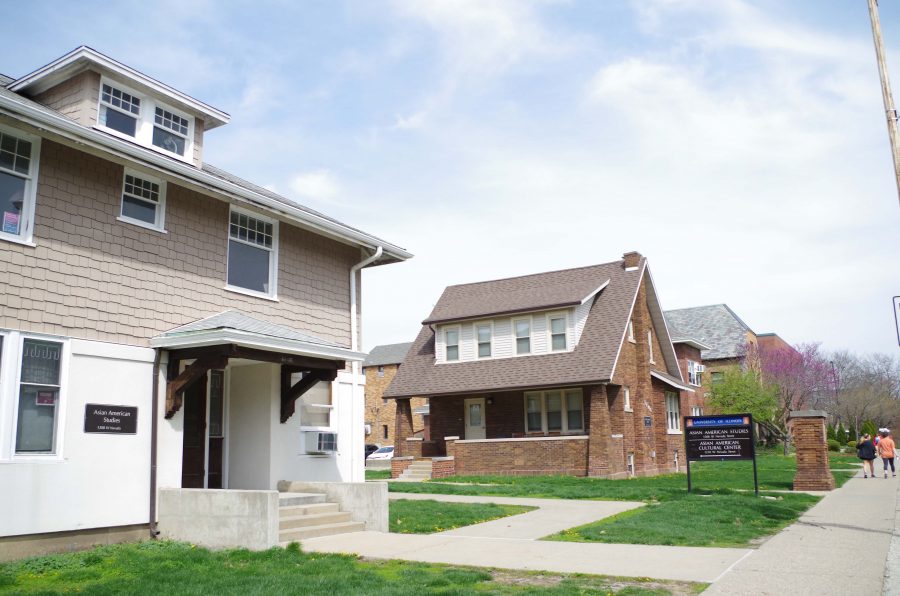Students push for a Middle Eastern-North African cultural house
The students for an Arab Cultural Center are pushing for a Middle Eastern, North African cultural house addition. The Asian American cultural house is one of many resources on Nevada Street symbolizing diversity on campus.
Apr 9, 2017
Nevada Street, the University’s self-proclaimed epicenter of inclusivity and diversity, is home to a handful of cultural houses. Hundreds of students pass these houses each day.
However, the effort toward inclusivity isn’t as simple as it seems. For over two years, talks of a potential Middle Eastern-North African, or Arab, cultural house have been floating around campus.
The discussion first sparked when Akram Almasri, graduate in LAS, received the Learn, Envision, Navigate and Synthesize certification through the Office of Inclusion. The program is a yearlong course designed to “teach through three lenses of diversity” and to equip students to engage with the unique American population.
In the latter half of the program, students design an action project to combat any form of oppression; Almasri, with a few other students in his cohort, decided to start the organization “Students for an Arab Cultural Center at Illinois” to help establish such a center on campus.
“We saw minimal support during meeting —almost no one came to our meetings aside from the Learn, Envision, Navigate and Synthesize cohort. We reached out to so many people and received little response,” Almasri said.
Get The Daily Illini in your inbox!
“We reached out to so many people and received little response.”
Students for an Arab Cultural Center believes creating the Cultural House will bring more inclusivity to campus; however, staunch opponents of it have targeted it as a means of dividing rather than uniting students.
“Many of the opponents to the (Cultural Center), even those who identify as an ethnic minority, said the cultural centers serve more to divide,” Almasri said.
Almasri passed the baton to Amira Hadyeh, junior in LAS and the new head of Students for an Arab Cultural Center.
“I’m trying to bring more awareness, going to (Arab Student Association) meetings, just so people know more about it,” said Hadyeh. “We have a flyer made, and we’re planning some more events once the weather gets warmer so we can rally campus support.”
Hadyeh’s game plan now includes bypassing administrative support and uniting the campus and Student Senate in support of the building of a cultural house. Hadyeh said various activist organizations through the RSO network have reached out in support of the organization, citing it as even more necessary given the current xenophobic political climate.
A major change in the logistics of the cultural house was when the name transitioned from “Arab” to “Middle Eastern-North African.”
Raneem Shamseldin, junior in Business and Student Senate president, emphasized the unique experience as an Afro-Arab student and the lack of a space to cater to this demographic.
Shamseldin said the inclusion of “North African” in the cultural house’s name essentially opens the doors to a small but growing demographic of students on campus from this background.
“Asian Americans have so many different cultures within (themselves) and Arab is just barely an aspect of that,” Shamseldin said.
“Even within the Arab community, there are differences between Kuwaitis and Saudis and Egyptians and Sudanese, so an Arab-Middle Eastern-North African cultural house will be covering a lot of sub-cultures.”
Given the recently public Divestment campaign, Students for an Arab Cultural Center has teamed up with Students for Justice in Palestine and received wide support for their movement.
Hadyeh said no one from the Jewish community has reached out with regards to the Arab cultural center.
“We aren’t trying to exclude them but I don’t think they would associate. Regardless, if they are willing, I would definitely work with them,” Hadyeh said.
Shamseldin had a similar approach to the issue — when politics are removed from the issue, the cultures are very similar and that it’s not fair to ask to be inclusive and then include everyone but the Jewish community.
Shamseldin went as far as to promote the cultural house as a safe space to discuss issues from both perspectives of the conflict.
Breaking bread, a century-old tradition for conflict resolution, may even be the force needed to bridge the divide between the two communities on campus.
The process of creating a cultural house is harrowing in and of itself, and the lack of administrative support seemed to be the cherry on top.
Since the start of the organization, the University administration has given no hint of financial support for a cultural house. Representatives within the administration even blatantly denied the possibility.
“We don’t have the funding for a project of that scope and it is really beyond talking about the details when we don’t have the funding for it,” wrote Gigi Secuban, associate vice-chancellor for Student Affairs, in an email.
A portion of cultural house funding is appropriated by the school budget.
Hadyeh said she believes the administration must figure out a way to fund the cultural house or funds should be acquired elsewhere.
“Honestly, all I see is a lack of campaigning right now — that’s part of why nothing is being done. The people in charge need to push it and it needs a lot of man hours. All we can do is put pressure on administration, and sometimes they bow down and sometimes they don’t,” Shamseldin said.






